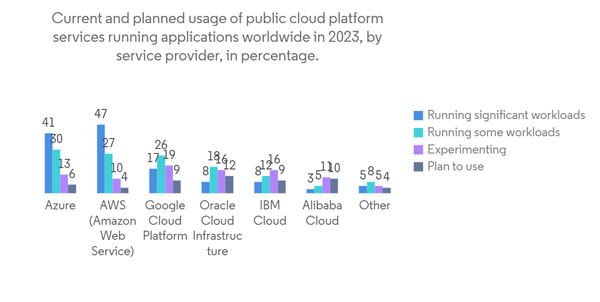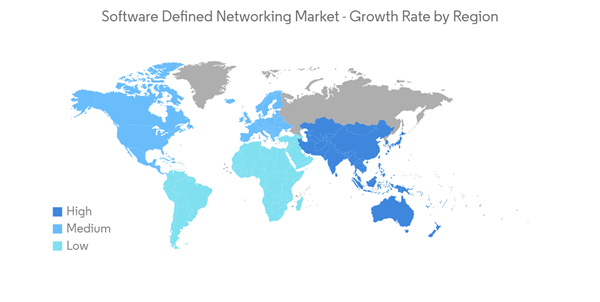Key Highlights
- The development of the global software-defined networking market is fuelled by key factors like a surge in the adoption of cloud computing, an increase in investments in software-defined networking function virtualization, especially to minimize the capital expenditure & operating expenses, and a rise in the need for various mobility services. The surge in the acceptance of cloud computing solutions in the SDN network plays a crucial role in improving the overall operability, security, and network manageability in advanced data centers.
- Moreover, the rising investments by various telecom service providers in 5G infrastructure would help to improve connectivity and maximize the deployment of SDN solutions. Also, the evolution of the 5G infrastructure network would help boost the SDN market's growth. According to 5G Americas, as of 2023, there are around 1.9 billion 5G subscriptions worldwide. It is anticipated to increase to about 2.8 billion by the end of the year 2024 and 5.9 billion by 2027, which in turn is expected to drive the market considerably.
- Also, the enterprise's propensity toward digitalization further propels the demand for robust network services. Many companies are looking to enhance their overall network capabilities, which is where Software Defined Network is gaining traction. For instance, in February 2023, ETSI Open Source Group TeraFlowSDN declared the 2nd launch of TeraFlowSDN controller, a robust and innovative SDN controller and orchestrator. TeraFlowSDN Release 2 delivers validated and extended support for slicing end-to-end transport networks over various domains.
- However, the lack of experienced and skilled network engineers and the rise in security risks and attack threats can restrict market growth throughout the forecast period.
- Since the outbreak of COVID-19, the demand for cloud-based solutions significantly grew owing to remote working models being adopted by enterprises. With the rising remote working model, companies maximized investments in cloud-based analytics and assurance, edge computing, and AI-powered networking technologies, which were expected to boost the studied market.
Software Defined Networking Market Trends
Telecom and Cloud-Based Service Provider is expected to witness a significant growth
- Software-defined networking is widely used in the IT and telecommunication industry due to advantages such as data traffic control and easily manageable large networks. The advancement of communication technologies, increased data consumption, the expansion of smartphone use, and the rise of internet traffic as a result of IoT/M2M connectivity together drive the adoption of software-defined networking in the telecommunications industry.
- Enterprises are striving to run their IT infrastructure efficiently and find ways to manage and operate their networks effectively. Enterprises are modernizing traditional IT techniques on commodity hardware, such as storage, computing, and networking, especially to incorporate cloud technologies that allow rapid deployment and development of new network services. With an increasing number of cloud-based applications across enterprises, cloud-based services are becoming significantly popular.
- Over the past decade, the total adoption of cloud computing has been rising mainly due to the increasing investments from small and medium enterprises. The cloud-based services are becoming prominent as the number of cloud-based apps in organizations grows. The overall usage of cloud computing has increased over the last decade, which is primarily due to the increased expenditures from small and medium-sized businesses.
- Moreover, various companies in the industry are parting to launch SDN solutions. For instance, in October 2022, EdgeQ Inc., a provider of 5G wireless infrastructure, and Vodafone, a global telecoms mobile operator in Open Radio Access Networks, collaborated to create the next-generation, software-programmable 5G ORAN systems. The partnership would utilize ORAN to provide the world's first open programmable, completely in-line L1 accelerator card to support multi-carrier, massive MIMO. To handle the 5G macro cell deployments, this massively integrated architecture converges the whole 4G/5G Physical layer into a single card.
- Additionally, In March 2022, Nokia declared that it was chosen exclusively to collaborate with Vodafone on creating software-defined network manager and controller (SDN-M&C) solutions for the multi-access fixed network technology of the company. Both companies are performing proof-of-concept studies in Europe under the terms of the partnership.
North America to Hold the Highest Market Share
- The North American region plays a very crucial role in terms of enhancing the growth of the software-defined network service market. It is mainly because of factors like the Inclining toward acceptance and implementation of advanced technology, development in network automation, the rise in the number of cloud-based services, and many others. Over the next five years, most IT teams are expected to increasingly adopt NaaS as suppliers provide hybrid offerings that involve software, cloud intelligence, and the alternative for the management of on-premises hardware devices.
- Moreover, substantial growth in connected and mobile devices is spiking the rise in the overall demand for enhanced network services. Since the United States has always stayed at the forefront of technology adoption, the region has witnessed the maximum adoption of connected devices, driving the market's growth opportunities significantly.
- Major companies in the region are collaborating and launching various solutions to remain competitive in the market. For instance, in June 2022, Kyndryl, the world's significant IT infrastructure services provider, and Cisco declared a technology partnership to help and assist enterprise customers boost their transformation into data-driven businesses mainly powered by Cisco solutions and Kyndryl managed services. Kyndryl and Cisco would also develop new private cloud services and networks, as well as edge computing solutions, software-defined networking solutions, and multi-network wide area network offerings delivered in an environment with various advanced security capabilities.
- Moreover, the increase in 5G rollouts and telecom companies across the region is playing a significant role in terms of driving market growth significantly. Also, the presence of various crucial SDN providers and the quick shift to 5G networks in this region positively impact the SDN market adoption. Further, the surge in the collaborations between 5G tech firms is becoming more common in the market for 5G technologies. This is mainly due to the firm's focus on building a solid 5G infrastructure and supporting creative platforms by pooling their resources, expertise, technology, and costs.
- Further, in June 2022, Qualcomm, a semiconductor firm located in the United States, acquired Cellwize Wireless Technologies Pte. Ltd. This acquisition is intended to improve Qualcomm Technologies' 5G network infrastructure, which would power the connected, intelligent edge, fuel the digital transformation of the sectors, and assist the rise of the cloud economy which in turn will augment the market growth drastically.
Software Defined Networking Industry Overview
The Global Software Defined Networking market is moderately competitive and comprises major players. In terms of market share, few key market players currently dominate the market. However, the massive adoption of cloud computing and blockchain is increasing the market's overall demand. Many companies are maximizing their market presence by securing new contracts and tapping new markets.In April 2023, CoreSite, a significant hybrid IT solutions provider and subsidiary of American Tower Corporation, declared the introduction of new enhanced network services to its software-defined networking platform, the Open Cloud Exchange. The new services would automate the additional provisioning functionality within the Oracle Cloud Infrastructure and direct its cloud-to-cloud communication capabilities on CoreSite's fully managed virtual routers.
In July 2022, Vodafone upgraded its software-defined networking (SDN) to integrate several supplier elements and modernize its worldwide transport network. Hundreds of millions of consumers, as well as independent internet and content providers, were served by this network, which coordinated all of the telco's mobile, fixed, and voice traffic across 28 nations on four continents.
Additional Benefits:
- The market estimate (ME) sheet in Excel format
- 3 months of analyst support
This product will be delivered within 2 business days.










